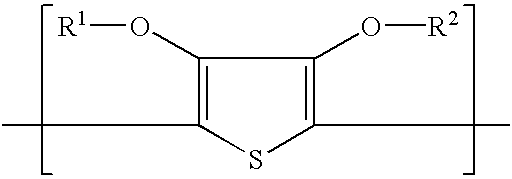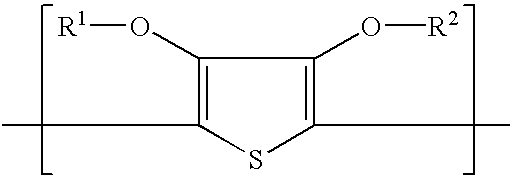Material and method for making an electroconductive pattern
a technology of electroconductive patterns and materials, applied in the field of materials and methods for making electroconductive patterns, can solve the problems of high fabrication cost, limited application range, low flexibility (pliability) and stretchability, etc., and achieve the effect of simple and convenient method
- Summary
- Abstract
- Description
- Claims
- Application Information
AI Technical Summary
Benefits of technology
Problems solved by technology
Method used
Image
Examples
example 1
EXAMPLE 1 discloses the evaluation of different monoaryldiazonium salts: MADS01 to 04, MADS07 and MADS08 incorporated in the PEDOT / PSS-containing outermost layer. Samples I to VIII were prepared by coating Support nr. 1 with the dispersions given in Table 1 to a wet thickness of 40 .mu.m followed by drying at 50.degree. C. for 5 minutes.
The resulting ingredient coverages with Samples I to VIII are given in Table 2.
The layers of Samples I to VIII were exposed through a mask on a PRINTON.TM. CDL 1502i UV contact exposure unit (from AGFA-GEVAERT N.V.) for 400 s at 4 mW / cm.sup.2 (=exposure of 1.6 J / cm.sup.2) with the samples above the glass filter, rinsed for 4 minutes with deionized water at room temperature and finally dried for 4 minutes at 50.degree. C. No difference was observed in the surface resistances observed whether exposure times of 100 s or 400 s were used as long as subsequent rinsing with water was carried out. Furthermore, the degradation process appeared to continue if ...
example 2
EXAMPLE 2 discloses the evaluation of different monoaryldiazonium salts: MADS05 to 07 incorporated in the PEDOT / PSS-containing outermost layer. Samples IX to XIV were prepared by coating Support nr. 1 with the dispersions given in Table 4 to a wet thickness of 40 .mu.m followed by drying at 50.degree. C. for 5 minutes.
The ingredient coverages of the dried layers of Samples IX to XIV are given in Table 5.
The layers of Samples IX to XIV were exposed through a mask on a PRINTON.TM. CDL 1502i UV contact exposure unit (from AGFA-GEVAERT N.V.) for 400 s at 4 mW / cm.sup.2 (=exposure of 1.6 J / cm.sup.2) with the samples above the glass filter, rinsed for 4 minutes with deionized water at room temperature and finally dried for 4 minutes at 50.degree. C. The surface resistances of the non-exposed and exposed areas of the light-exposure differentiable element before and after rinsing with water are given in Table 6.
All samples containing mono(aryldiazosulphonate) compounds exhibited a differenti...
example 3
EXAMPLE 3 discloses the evaluation of different monoaryldiazonium salts: MADS01 incorporated in the PEDOT / PSS-containing outermost layer in different concentrations. Samples XV to XX were prepared by coating Support nr. 1 with the dispersions given in Table 7 to a wet thickness of 40 .mu.m. The ingredient coverages in Samples XV to XIX after drying at 50.degree. C. for 5 minutes are also given in Table 7.
The layers of Samples XV to XX were exposed through a mask on a PRINTON.TM. CDL 1502i UV contact exposure unit (from AGFA-GEVAERT N.V.) for 400 s at 4 mW / cm.sup.2 (=exposure of 1.6 J / cm.sup.2) with the samples above the glass filter, rinsed for 4 minutes with deionized water at room temperature and finally dried for 4 minutes at 50.degree. C. The surface resistances of the non-exposed and exposed areas of the light-exposure differentiable element before and after rinsing with water are given in Table 8.
The results in Table 8 show that the differentiation in surface resistance (R.sub...
PUM
| Property | Measurement | Unit |
|---|---|---|
| temperatures | aaaaa | aaaaa |
| temperature | aaaaa | aaaaa |
| temperature | aaaaa | aaaaa |
Abstract
Description
Claims
Application Information
 Login to View More
Login to View More - R&D
- Intellectual Property
- Life Sciences
- Materials
- Tech Scout
- Unparalleled Data Quality
- Higher Quality Content
- 60% Fewer Hallucinations
Browse by: Latest US Patents, China's latest patents, Technical Efficacy Thesaurus, Application Domain, Technology Topic, Popular Technical Reports.
© 2025 PatSnap. All rights reserved.Legal|Privacy policy|Modern Slavery Act Transparency Statement|Sitemap|About US| Contact US: help@patsnap.com



